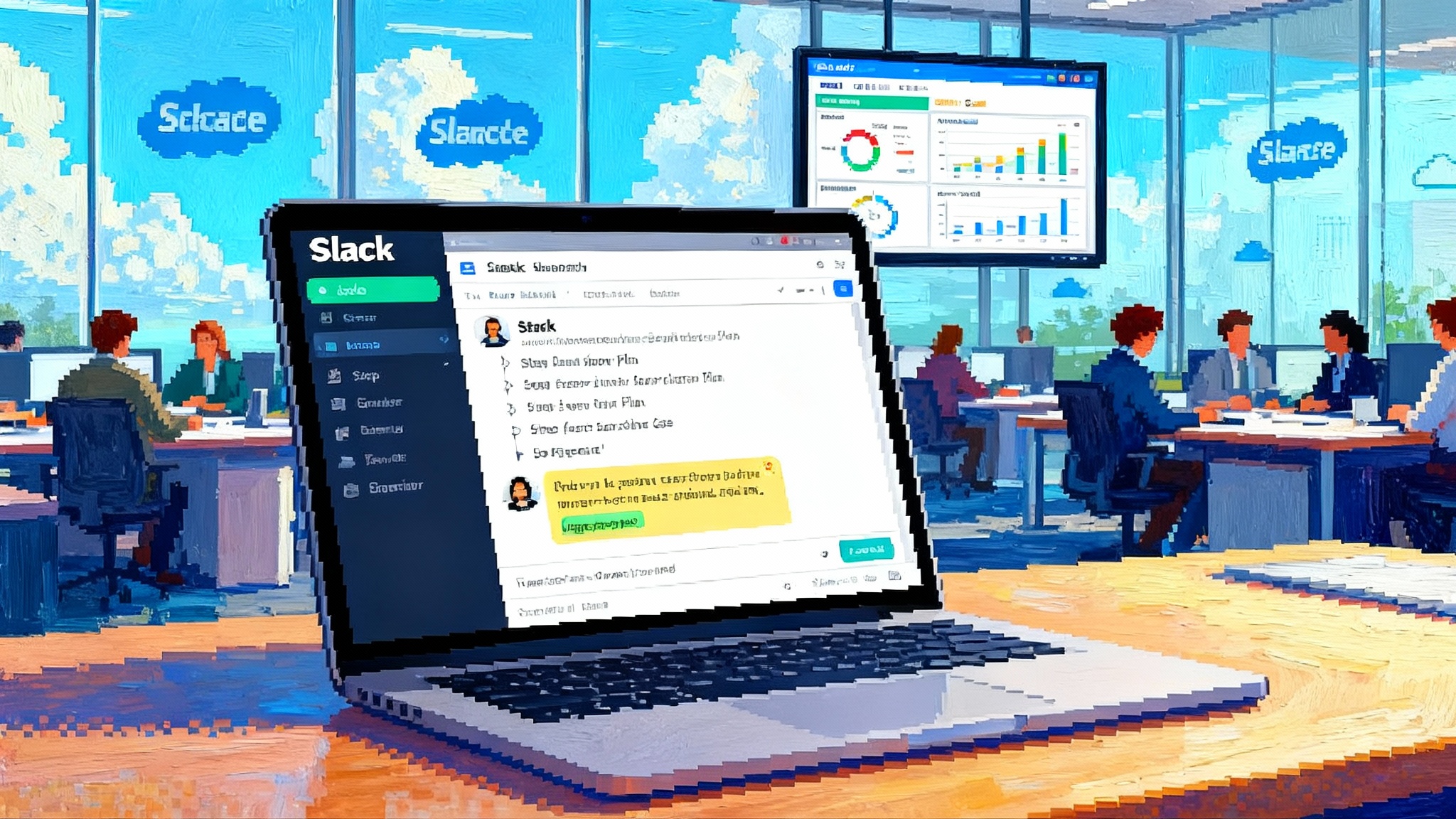Agentforce 360 Makes Enterprise AI Agents Finally Real
Salesforce just moved enterprise AI agents from demos to production with Agentforce 360 embedded in Customer 360 and Slack. Here is the architecture, a 30‑day pilot, and the metrics leaders should track to prove ROI fast.

The breakthrough: agents move from slick demos to shipped software
On October 14, 2025, Salesforce announced Agentforce 360 as a globally available platform for enterprise agents embedded across Customer 360 and Slack. The release puts governed, production-grade agents inside the systems where work already happens, and it comes with model choice across Google, OpenAI, and Anthropic. Salesforce positions this as the arrival of the agentic enterprise, with agents that can reason, take action, and stay within corporate guardrails. See the official launch details in Salesforce’s press release for Agentforce 360 general availability press release.
Two days later, Salesforce and Google expanded their partnership to bring Google’s Gemini models deeper into Agentforce 360 and to tighten the loop between agents, Slack, and Google Workspace. That matters because it brings multimodal perception, large context windows, and familiar productivity surfaces to the agent workflow. Read the joint update on the Google and Agentforce 360 expansion announcement. For how Workspace is evolving into an agent OS, see Gemini Deep Research in Workspace.
If you have been waiting for signs that enterprise agents are viable beyond lab demos, this is the moment to look again. The shift is architectural more than cosmetic. Agents are not off to the side in a separate tool. They are native to customer relationship management, service, analytics, and Slack. That native placement changes reliability, security, and adoption dynamics.
Why this architecture finally makes agents shippable at scale
Enterprise agents have been stuck between two bad choices. Either they run as shadow scripts that call application programming interfaces without central controls, or they live as chat toys that cannot touch real systems. Agentforce 360 offers a third path: governed agents that operate where data, processes, and people already live.
Here are the four design choices that matter.
- Native data access with policy boundaries
- Agentforce 360 sits on top of Salesforce Data Cloud and the broader Customer 360 dataset. That means agents can retrieve records, documents, and events without fragile point-to-point connectors. Access is scoped by the same profiles, roles, and sharing rules used for humans. If a salesperson cannot see a high-value account, the sales agent cannot either. This shrinks the perennial data-leak risk and reduces integration drift.
- Hybrid reasoning and deterministic actions
- Salesforce’s Atlas Reasoning Engine combines language model reasoning with structured steps defined in flows, prompts, and policies. Think of it like a pilot that can improvise during turbulence but must file the flight plan and stick to waypoints. The agent generates plans in natural language, but execution happens through governed tools: case actions, opportunity updates, entitlements, or approval requests. This blend reduces hallucinations because the critical steps are codified as callable actions, not freeform text.
- Model choice without platform rewrites
- Enterprises rarely pick one model forever. With Agentforce 360, teams can select Gemini, OpenAI, or Anthropic for specific tasks, and can route requests through providers like Amazon Bedrock for preferred hosting. That lets security teams keep sensitive workloads on a particular provider while product teams try newer models for creative tasks. Model neutrality is wired into the agent builder and policies, so switching a model does not force a rebuild of the surrounding workflow. For a related approach, see OpenAI AgentKit for production agents.
- Slack as the operating surface
- Slack becomes the place where agents converse, request approvals, and show their work. The new Slack-native AgentExchange makes agents discoverable and installable the way apps are today. A support lead can watch an agent triage a surge of tickets in a Slack channel, then take over when needed. Visibility equals trust. If agents act in the same feed where leaders work, adoption accelerates. This mirrors the rise of new agent app stores.
The result is not a chatbot that guesses. It is a workflow participant that reasons within boundaries, uses the same permissions as your staff, and logs every step.
What this changes for sales, service, and IT
Sales, service, and information technology teams do repetitive work that is full of tiny rules. Those rules are why naive chat bots failed. Agentforce 360 changes the unit of work from a single chat turn to an end-to-end task with both reasoning and action-taking.
Sales
- Pipeline shaping becomes continuous. An agent monitors lead sources, enrichment signals, and sequence performance. It can reassign a lead, adjust a cadence, and draft the next outreach, all in one run, while observing do-not-contact rules and industry compliance.
- Account planning becomes multiplayer. Agents assemble a shared brief from sales notes, product telemetry, and past meeting transcripts. The brief is posted in Slack, tagged to the opportunity, and updated after each touch. No more stale account plans.
- Forecasting gets backbone. Agents reconcile opportunity stages with activity reality, flag slip risks, and nudge owners with specific actions that have worked for similar deals.
Service
- Auto-triage improves because the agent has grounded context. It can see entitlements, prior escalations, knowledge coverage, and inventory. It routes and drafts a first response that cites the exact article and logs what it did.
- Root-cause swarm is structured. When a spike hits, the agent gathers the right people into a Slack channel with a timeline, top patterns, and proposed playbooks. Humans still lead the fix, but the agent handles the data scut work.
- Deflection is measurable. Agents handle password resets or warranty checks directly in customer channels, record the savings, and share what content gaps caused handoffs.
IT and internal services
- Joiner, mover, leaver flows become reliable. The agent requests approvals, provisions apps, and validates access against policy. Exceptions go to Slack with an audit trail.
- Knowledge stays fresh. The agent watches ticket tags and aging articles, drafts updates, and proposes new entries when patterns emerge.
- FinOps and SecOps get help without ceding control. Agents close low-risk alerts, open change requests, and collect logs. High-risk actions require human thumbs-up.
In each case the agent is a colleague, not a novelty. It drafts, proposes, and acts within your rules.
A pragmatic 30-day pilot to prove return on investment fast
You do not need a lab or a long program to know if this will pay off. Here is a pilot that any director can run in four weeks.
Scope and team
- Use case: pick one outcome where agents can both reason and act. Examples: auto-triage for top three service categories, or sales lead requalification and sequencing for a specific region.
- Team: one product owner, one subject matter expert, one admin, one data steward, one security reviewer, one change-management lead. Limit time to eight hours per person per week.
- Success criteria: 20 percent faster time to first response for service, or 10 percent higher conversion for requalified leads. Define exact baselines on day one.
Data and guardrails
- Data: list the objects, fields, and knowledge sources. Identify sensitive data and remove it from the pilot scope if you cannot mask it.
- Permissions: mirror human roles. Agents cannot see more than the humans they augment.
- Actions: start with three to five allowed actions, like case reassign, comment draft, sequence apply, or task create. Everything else is read-only until week three.
Week by week plan
Week 1: frame and simulate
- Map the task into steps. Write success and failure examples.
- Configure the agent in Agentforce Builder. Set prompts, policies, and tool actions.
- Simulate five common flows and five edge cases. Use the live debugging view to inspect reasoning traces and outputs.
- Deliverable: a one-page operating spec that lists inputs, steps, allowed actions, and escalation rules.
Week 2: run in shadow mode
- Turn on the agent for a subset of records but keep it in suggest-only mode.
- Measure precision. When the agent recommends an action, did the human accept it and why?
- Collect drift cases. Where did context run out or a rule was unclear?
- Deliverable: an error taxonomy with fixes. Add missing knowledge snippets and clarify policies.
Week 3: limited actions with approvals
- Enable a small set of actions with human signoff in Slack. Examples: apply a sales cadence, reassign a case, or draft an email and file it to the record.
- Add timeouts. If no human responds in 15 minutes on a low-risk item, the agent can proceed. If high risk, it must wait.
- Deliverable: initial savings estimate. Calculate minutes saved per item times volume. Start a running return on investment model.
Week 4: expand scope and measure outcomes
- Open the agent to the full pilot population. Keep observability on.
- Generate a weekly report. Show acceptance rate, action success rate, escalations, and time saved.
- Hold a retro. What will it take to 5x the scope without losing control?
- Deliverable: a decision memo with go or no-go and a clear scale plan.
How to measure value
- Service: time to first response, time to resolution, deflection rate, article freshness, and percent of actions performed by the agent without correction.
- Sales: conversion on requalified leads, meeting set rate, cycle time, and forecast accuracy delta.
- IT: average time to provision, policy violation rate, and fraction of tickets fully resolved by the agent.
What you need to budget
- Platform: license impact for Agentforce capabilities and Slack enterprise features.
- People: two to three part-time roles across product, admin, and security.
- Change: training hours and communications. Plan one playbook per persona.
Under the hood: how hybrid reasoning reduces risk
Think of agent runs as miniature projects with explicit steps. The agent first plans with a model. Then it executes steps through governed tools. Each step has preconditions and inputs. If a step fails, the agent interprets the error and either retries, requests help, or stops. The key is that plans are suggestions, but actions are deterministic and auditable.
Grounded context matters just as much. Intelligent context brings unstructured files, transcripts, and past cases into the run, but through managed connectors and caches. Instead of sending entire documents back and forth, the agent extracts the relevant section, cites it, and attaches the evidence to the record. That makes reasoning explainable and reduces data exposure.
Finally, model routing reduces vendor lock-in. You can give one model the planning step and another the summarization or translation step. If a regulator or a security officer prefers a model hosted on a particular cloud region for a given workload, routing makes that a configuration choice rather than a rebuild.
The Slack effect: adoption through visibility
Most failed automation fails in silence. The work happens somewhere nobody can see. Slack reverses that. When agent runs show up as threads, leaders can review decisions in the same place they already approve expenses and read customer escalations. That boosts trust and speeds iteration. It also helps training. New team members learn by watching agents and experts work through the same threads.
For frontline teams the benefit is even simpler. They stay in one place. Drafts, approvals, knowledge, and actions live in the same conversational surface. The agent does not drag people into a new tool. It joins the team where the team already works.
Pitfalls to anticipate and how to avoid them
- Vague goals: do not launch an agent for efficiency. Pick a task with a measurable finish line, like cutting first-response time by 20 percent for three categories.
- Over-permissioning: do not grant broad read access to make the agent smart. Start with the same view that a human has. Expand only when the benefit is clear.
- Silent errors: make Slack the front stage. Require the agent to post its plan and a short rationale for every high-impact action.
- Content gaps: when the agent stalls, it is usually missing a fact. Track which questions cause human handoffs and update the knowledge source weekly.
- Model monoculture: do not treat one model as the answer to all problems. Route planning, classification, and summarization to different models when it helps accuracy or cost.
What this means for leaders
- Chief information officer: you can modernize workflows without a big-bang migration. Start with one agent that augments your most expensive bottleneck. Keep controls and audit in the systems you already trust.
- Chief revenue officer: ask for a pilot that requalifies a defined lead pool and reshapes cadences without changing your sales stack. Demand conversion lift in four weeks.
- Head of customer service: turn a top call driver into a closed loop. The agent drafts, routes, follows up, and updates the article that prevented the next call.
- Security and compliance: you get central policy, trace logs, and deterministic action points. Approve a small scope and script the escalation path before scale.
Why this moment is different
The difference is not another chat interface. It is the union of three ingredients that have rarely shipped together.
- Data gravity: agents now live where the customer and operational data already sits. That kills fragile integrations and improves grounding.
- Controls by default: permissions, audit, and approvals are part of the agent runtime. That boosts trust and reduces the cost of exceptions.
- Model neutrality: organizations are free to pick models for each job. That keeps optionality as the landscape evolves.
Put those together and you get agents that can actually own outcomes without creating new risk.
The bottom line
Agentforce 360 is not a magic wand. It is a practical shape for enterprise agents that finally fits how companies work. The technology is interesting, but the implications are better: fewer swivel-chair tasks, faster cycles, and decisions that explain themselves. If you want to know whether this is real for your team, run the 30-day pilot above with simple rules. Keep the agent inside your permissions, centralize actions, watch it in Slack, and measure one outcome that matters. If it pays off, scale the scope. If it does not, you will know exactly why.
That is how you cut through the noise. You do not wait for perfect. You ship a small agent that does one valuable thing, you watch it work in the open, and you let the results decide what comes next.








